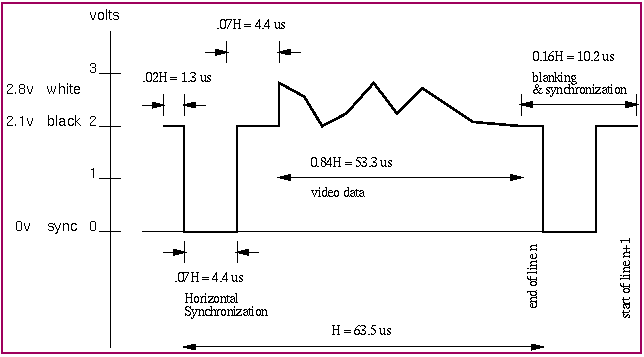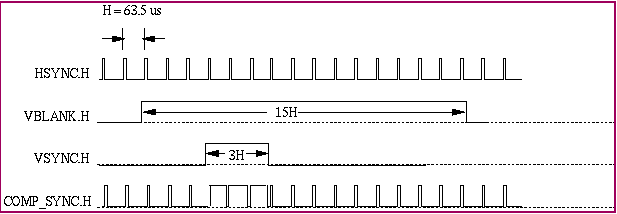The video scan
consists of 260+ horizontal lines containing intensity information, along
with a bunch of other analog stuff to make sure that the lines line up
with each other (synchronization, or "sync", information) and to make sure
that you don't write on the screen when the electron beam deflection circuitry
is scanning back across the page (blanking). The format of this signal
comes from an earlier age when the world was analog and displays were made
using electron guns and phosphors.

The video signal generated by the camera is a composite video signal.
That is, the video data (gray levels), horizontal and vertical synchronization
information is all encoded on a single wire. The television locks
on to the horizontal and vertical sync information in the video signal.
Horizontal sync defines the beginning of a new line, and vertical sync
defines the beginning of a new field. The horizontal sweep rate is 60 fields
per sec times 262.5 lines per field or 15.75 KHz.The horizontal sweep
interval is divided into three portions as: blanking, synchronization,
and data. Each line lasts 63.5 microseoncds (= 1.0/15.75KHz). Retrace
occurs during the blanking interval, and the leftmost visible data occurs
at the end of the blanking interval. The horizontal synchronization signal
occurs approximately in the middle of the blanking interval. Note that
the video signal is analog, not binary, with levels from white to black,
to synch.
So a single horizontal line of video (shown below) lasts for 63.5 microseconds
and has several components. The longest piece is the analog signal
that represents the intensity of the image as a function of time (position
along the scan line). That analog piece is 53 microseconds long.
After the analog signal, there is some semi-digital information that tells
the TV (or your project's FSM) exactly when the next line is about to start
relative to the last one. This is the horizontal sync signal.
In addition to the horizontal sync signal, at the end of each frame
of video there is a vertical sync signal that indicates when the next frame
is going to start, and which tells the TV's controller to turn off the
electron gun while the beam deflection circuits are bringing the beam back
to the top left corner of the screen. The actual encoding of the
vertical sync information is a bit cryptic, but you've got a chip on your
board that takes the video signal and gives you a clear vertical sync signal.

Don't forget that the video signals are all asynchronous as far as your
Xilinx board is concerned. Treat them with caution!
The various sync signals are shown below . Note that the vertical
blanking interval is roughly 1 millisecond long. This gives you plenty
of time to think, do some math on a good sized chunk of a frame, transmit
information on the serial line, etc.

Since the vertical scan is much slower than the horizontal scan, a longer
vertical blanking interval used to be necessary to avoid seeing the retrace
lines. The example in the figure indicates a blanking time of 15 horizontal
periods. How many horizontal lines will be visible? Approximately 247 (=
262 -15) lines. The standard blanking interval is between 18 and 21 horizontal
periods. It is ok if your design misses a few lines on the top or
bottom of the screen. A wide SYNC pulse triggers the vertical oscillator
in the monitor to start another cycle, however, the horizontal oscillator
must be kept synchronized during this time. Hence the serrations in the
COMP_SYNCH.H signal.
Figuring out where the top and left side of the image is could be complicated.
Fortunately, you will be using the LM1881
sync separator in checkpoint 2. It takes as input the composite video
signal, and provides outputs of vertical sync and composite sync. So to
find the beginning of the video frame, wait about 17 horizontal periods
after the vertical sync signal goes low. Then begin reading in video
data about 8.8 microseconds after the composite sync goes low. Read a line,
then wait for the next line until you have read all the lines you need.
For more info on the video signal, see checkpoint
2.


